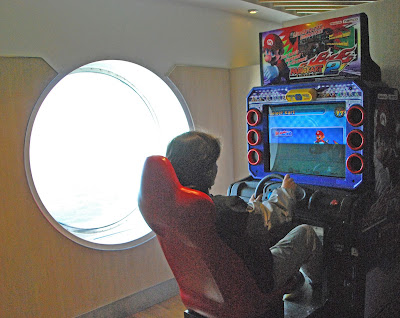We had a lovely ferry ride across a smooth Strait of Dover, or Dover Strait, or Dover Narrows. Whatever you call it, it's the strait at the narrowest part of the English Channel, marking the boundary between the Channel and North Sea, separating Great Britain from continental Europe.
We drove our car off the ferry, and had a short drive to the lovely Dunkerque waterfront business district.
We parked in a lot right across from the "Operation Dynamo" or Dunkerque 1940 museum. More on that destination later.
We explored the grounds near the museum, and quickly spied this new art installation.
Dunkerque was home to one of the most told stories about the Allied war effort. Back in 1940, Allied soldiers were cut off and surrounded in the city. Many were killed, but miraculously hundreds of thousands escaped, in large part thanks to civilian boats who came to pick them up off the beach.
For the sculpture we were fortunate to visit, according to a sign on site, the artist chose the Hourglass, "a symbol of passing time, as an analogy for the Allied soldiers trapped in the Dunkirk pocket who slowly trickled out to sea as they were evacuated. This work, which commemorates the success of Operation Dynamo, also pays homage to the soldiers killed or reported missing between 26 May and 4 June, 1940. Moreover, the Hourglass symbolizes the possibility of a reversal capable of turning a defeat into a victory." The installation is called Le Sablier. It's by Severine Hubard, and was dedicated on 12 July 2017.
We were also able to see yet another new-ish installation at Dunkirk, this dramatic bridge over a canal near the beachfront.
There were still some construction signs and fences in the area, but we were able to access the bridge and read the dedication wall adjacent to it.
We also spied a lighthouse. Tonight, via Wikipedia, I learned it "s an automated first order (i.e. 60 km beam or further) port lighthouse, the highest of this type in France. It is sited near Dunkirk. Construction on the lighthouse was completed in 1843."

Here's a longer shot looking south. You can barely see the lighthouse in the center left of the frame below.
Looking toward the north, you start to see restaurant row along the beachfront.Meanwhile, out on the water, a few sailboats bobbed.
The kids dug into the sand and were struck by how powdery fine it was.

While walking north along the waterfront, we heard what sounded like a marching band in the distance. We finally came across them. They were Les Pet'Boontjes, and they happened to be playing a song by the Offspring (an American band whose peak of popularity was in the '90s) at the moment.
Based on signage we saw in the area, we surmised they were playing along a run/walk route that was a fund raiser to fight cancer.
We kept walking and came to a stretch where there were a couple dozen restaurants all in a row. We checked out menus they had posted, and looked on tables of diners, and finally would up at this place.
The kids ordered what I'll call "American fare" (a burger and Annabelle had spaghetti bolognese). I had scrambled eggs. Christian ordered something, not sure what he was getting. As he looked around the restaurant, he was coveting the huge crocks of mussels and the plates of frites (fries) they came with and said he sure hoped he was getting that.
He was so happy when his order arrived. :)
After lunch, we returned to the Dunkerque in 1940 museum.
We'd seen the movie "Dunkirk" recently and, honestly, the lovely day on the sunny beach was such a far cry from the Dunkirk portrayed in the movie, where it was dark, cold and under constant bombardment.
Below is a flyer Nazi troops dropped on penned-in Allied soldiers to let them know how dire their circumstance was.
The museum was small - in a former underground bunker.
However, it has a comprehensive collection of artifacts, thoughtfully displayed.Some of the things that caught my eye were these rifles from the shipwreck of the Norwegian ship Tindejfell or Le Fred on 28 May 1942.
This brown leather allied bomber jacket was absolutely lovely. It looked like it was made yesterday.
The museum had Allied soldiers' supplies on display ...
Overall, it was a great visit to Dunkirk/Dunkerque, and afterward, we were off on our next adventure - to Belgium and beyond!
Dunkirk is a city in northern France best known for being the site of the Dunkirk Evacuation (codenamed "Operation Dynamo"). We visited Dunkirk during our 2017 trip to Europe.
We got to Dunkirk by ferry (detailed in my last writing for MPA), from Dover, England. After a bit of driving, we got into the city, specifically, a long beach and street area. At the time, the street was host to a cancer run, if I remember correctly. The street had a large number of restaurants, many of which served mussels with fries (which is apparently a tradition on the coast of France). At the restaurant we went to, I had a burger with fries.
After the restaurant, I spent some time in the beach by the street. I'f I'm correct, that would mean that my feet were in the English channel during that visit. Afterwards, we went to a museum, featuring World War II (in particular Operation Dynamo) artifacts from both the Allies and the Axis.
























































